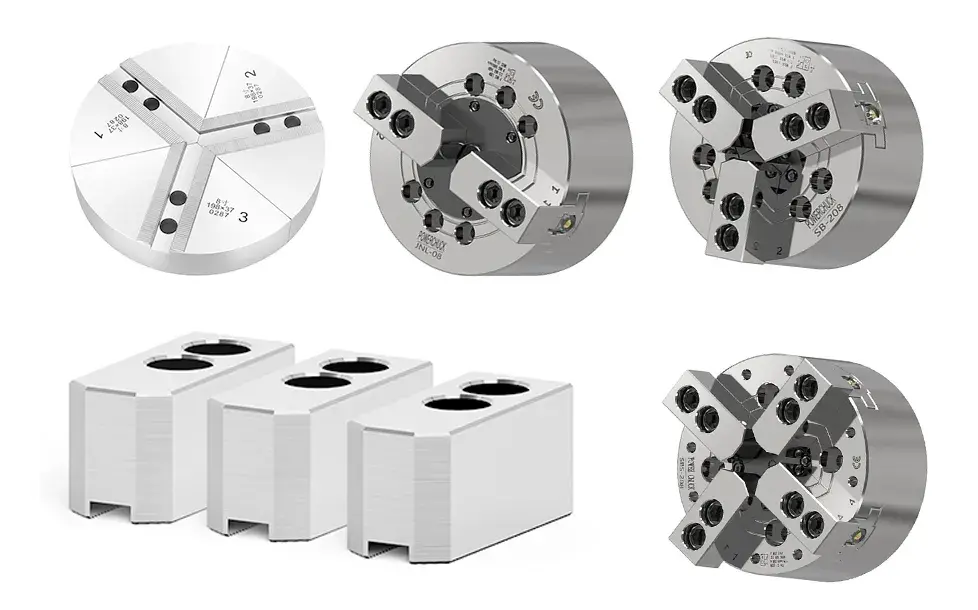Uses of Three Jaw Chuck
Three jaw chuck is a versatile tool used in various cnc machining applications. It is instrumental in holding round or irregularly shaped objects that other types of chucks cannot securely hold. Some common applications of Three jaw chuck include:
- Turning operations: Three jaw chuck grasp is often used in cnc turning operations to hold round or irregularly shaped objects, such as shafts, pipes, and cylinders.
- Drilling operations: Three jaw chuck grasp can be used to hold drill bits during drilling operations, ensuring that the bit remains in position and does not move.
- Milling operations: Three jaw chuck grasp is also used in cnc milling operations to securely hold workpieces in place while milling.
Advantages of Three Jaw Chuck
Three jaw chuck grasp offers several advantages over other types of chucks:
- Versatility: Three jaw chuck grasp can hold a wide range of object shapes and sizes, making it a versatile tool for machining.
- Easy to use: Three jaw chuck grasp is easy to use and requires minimal setup time, making it a popular choice for machinists.
- Consistent grip: Three jaw chuck grasp provides a consistent grip on the object, ensuring that it remains securely in place during machining operations.
Disadvantages of 3 Jaw Chuck
Despite its many advantages, Three jaw chuck grasp also has some disadvantages:
- Limited grip: Three jaw chuck grasp may need to be able to hold objects with a large diameter or irregular shape as securely as other types of chucks.
- Difficulty in centering: Three jaw chuck grasp may be more difficult to center than other types of chucks, which can lead to inaccuracies in machining.
- Wear and tear: Three jaw chuck grasp may wear out more quickly than other types of chucks due to the constant movement of the jaws.
Comparison Between 3 Jaw Chuck and 4 Jaw Chuck Grasp
When it comes to holding objects in machining, both three-jaw chuck grasp and four-jaw chuck grasp are commonly used. While they serve similar functions, there are several differences between them. Here are some of the main differences between the two types of chucks:
- Number of Jaws: The most obvious difference between the two chucks is the number of jaws. Three-jaw chuck grasp has three jaws, while four-jaw chuck grasp has four jaws.
- Centering: Centering an object in a three-jaw chuck grasp can be more difficult than centering it in a four-jaw chuck grasp, which can lead to inaccuracies in machining.
- Object Shape: Three-jaw chuck grasp is more suited to holding round or irregularly shaped objects, while four-jaw chuck grasp is better suited to holding square or rectangular objects.
- Holding Capacity: Four-jaw chuck grasp generally has a higher holding capacity than three-jaw chuck grasp, meaning it can hold larger or heavier objects.
- Adjustability: Four-jaw chuck grasp is more adjustable than three-jaw chuck grasp, as each jaw can be moved independently to hold objects of different sizes and shapes.
- Ease of Use: Three-jaw chuck grasp is generally easier to use than four-jaw chuck grasp, as it requires fewer adjustments to hold an object in place.
- Accuracy: Four-jaw chuck grasp is generally more accurate than three-jaw chuck grasp, as each jaw can be adjusted independently to ensure a precise grip on the object. Four-jaw chuck grasp can typically achieve an accuracy of up to 0.001 inches, while three-jaw chuck grasp has an accuracy of around 0.005 inches.
- Price: Three-jaw chuck grasp is generally less expensive than four-jaw chuck grasp, making it a more cost-effective option for some machining applications.
- Speed: Three-jaw chuck grasp is faster to set up and use than four-jaw chuck grasp, which can save time in high-volume machining operations.
- Repeatability: Four-jaw chuck grasp offers better repeatability than three-jaw chuck grasp, meaning that it can hold objects in the same position with greater consistency from one machining operation to the next.
Six Common Types of Lathe Chucks in Machining
- Jawed Chuck: This type of lathe chuck is also known as a self-centering chuck or scroll chuck. It uses three or four jaws that move simultaneously to hold round or irregularly shaped objects.
- Collet Chuck: This type of lathe chuck is designed for holding small, cylindrical objects, such as drill bits or end mills. Collet chucks are often used in precision machining applications.
- Drill Chuck: This type of lathe chuck is designed specifically for holding drill bits. It has a straight shank that fits into the spindle of the lathe and three jaws that grip the drill bit.
- Magnetic Chuck: This type of lathe chuck uses a magnetic field to hold objects in place, making it ideal for holding flat, ferrous objects. Magnetic chucks are often used in grinding and EDM (electrical discharge machining) applications.
- Combination Chuck: This type of lathe chuck combines the features of a jawed chuck and a collet chuck. It has a collet in the center for holding small, cylindrical objects and jaws around the perimeter for holding larger objects.
- Air Operated Chuck: This type of lathe chuck uses compressed air to hold objects in place, providing a strong grip on irregularly shaped objects. Air operated chucks are often used in high-speed machining applications.





